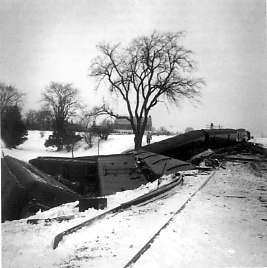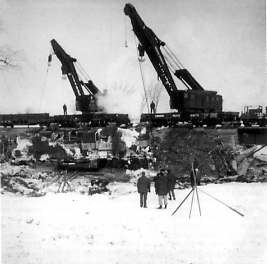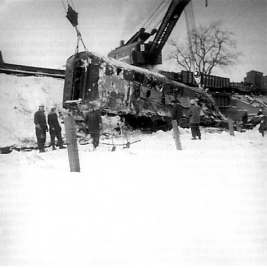Details of Railway Accidents in the Ottawa Area

1962, January 7 - "The Dominion" derails three diesels (8474-1902-1910) and several cars at St. Eugene, Canadian Pacific, M and O subdivision.

| .Tid Bits by Duncan
H. du Fresne,
Branchline, December 2006. CP
Train No. 8 - "The Dominion"
The following incident involving CP train No. 8 near St. Eugene,
Ontario, at mileage 27.4 of the former M & O subdivision, on
January 7, 1962, holds a special memory for me for several reasons. I
left CP as a locomotive fireman in 1957. It was not easy. I had been a
company employee for 1 2 years, never much wanted to do anything else
but be an engineman, and I must admit it was the steam locomotive that
made me think the way I did (and still do). In any event circumstances
well beyond my control and understanding (the introduction of
diesel-electric power and the elimination of firemen) resulted in my
having to leave CP and do something else with my life. That "something
else" (by pure luck) resulted in my joining the Federal Government's
Department of Transport as a trainee Air Traffic Controller. I started
training at the Department's ab-initio (VFR) school at Malton Airport
(Toronto). Again, it was not easy. It was a very tough course and, for
me, having little formal education which ended at age 1 5 when I joined
CP, meant that getting my nose into the books was something I never had
much experience with. But, when your back is against the wall and you
have to do something, it can surprise you just what you're capable of.Jump ahead a few years. Unlike the railway, advancement in the air traffic control business, for those who fitted in, was fast and furious. After more courses I very quickly advanced to become an (IFR) air traffic controller. This, after nearly three years of working in what amounted to a "probationary" period, I had reached my goal. (When I started I really didn't know what my "goal" was!) At that time (the late-1950s) the Department was introducing radar for air traffic control purposes and, once again, I quickly went through the training and became qualified to control IFR (instrument flight rules) traffic using radar. Jump ahead to 1962. Now, with a few years experience behind me with the use of this new control "tool" at the Ottawa Terminal Control Unit, I learned that this early radar system (AASR-1, for those of you who may be interested) had several idiosyncrasies, not the least of which was that of detecting large moving objects on the ground as well as in the air (a small change in the "tilt" of the antenna corrected this), however, on the morning of January 7, 1962, yours truly was working as the departure controller when I spotted a slow moving target moving away from Ottawa in an easterly direction. There was little doubt about it, it was a ground target. A quick 'phone call told me that CP train No. 8, with 11 cars, had just departed the old Ottawa Union Station and was east of Hurdman. I was following the progress over the ground of that train on air traffic control radar!! Well it didn't last all that long but I did get intermittent "hits" on the train for about 20 miles. This really amused me and I told my controller colleagues to take a look. It also brought back a lot of memories of my days on CP as I, from time to time as a spare fireman, got called for No. 8 to Montreal. In the steam era, this was a very good job for there was a lot of "miles" (pay) in it as there was a lot of terminal detention time in Montreal (Windsor Station) and the return of the "draft" to the Glen Yard which was done about as slow as a Hudson could turn her driving wheels (no point in being in a hurry when you're making money). Sometime later I heard the news. Train No. 8, "The Dominion", had derailed near St. Eugene, Ontario (just west of the Ontario/Quebec boundary). No one had been killed in the accident, but there were injuries. Most notable, for me anyway, was the engine crew of Harold Greenlaw (engineer) and Frank Alexander (fireman), both long service company employees and former colleagues and friends. Both men were returned to Ottawa and ended up sharing the same room at the Ottawa Civic Hospital where they enjoyed giving the nurses a hard time. They both had been bruised up pretty good and I just can't remember or not about broken bones.
Meanwhile, back at St. Eugene. Auxiliaries were sent out to the site from both St. Luc in Montreal and Smiths Falls (Ontario) to clean up the mess. While I have not been able to determine which cranes were used, the St. Luc crane appears to be a modern 250-ton Industrial Brownhoist. The Smiths Falls crane, although slightly smaller, was still steam powered. The conductor on the Smiths Falls auxiliary was my old friend, Don Gaw. In fact it was Don who took the photographs that accompany this Tid Bit. He ultimately became a member of the Bytown Railway Society (BRS) and many members of the Society accompanied him on his retirement trip from Ottawa to Sudbury and back on the local Budd car(s) in 1 983. Don is no longer with us but his brother Sam (J.C.), also a one time C.P. railroader, is, and is also a BRS member. So, were these wrecked first generation units scrapped? Nope! They were traded in for second generation power. The 8474 went back to MLW for more modern C-424 unit No. 8300 (and later renumbered No. 4200). Similarly, GMD F9B unit 1902 became GP30 8200 (later 5000), and F7B 1910 became GP30 8201 (later 5001). Bytown Railway Society,, Branchline, December 2006, pages 10-11. Ottawa Citizen Monday 8 January 1962 114 Shaken Up In Rail Wreck See Also Page 16 By Paul M. Dunn Citizen Staff Writer ST. EUGENE, Ont. Canadian Pacific continued their search today for clues to Sunday's derailment of the Vancouver-to-Montreal Dominion near here, 70 miles east of Ottawa. The derailment of the 14-unit train which dumped the three diesels into a 30-foot gully, left only the sleeping car on the tracks. There has been no official statement from the railway concerning cause of the derailment and subsequent damage. Among other things, completion of an investigation report depends upon statements from crew members. The accident occurred at 8.38 a.m. as the train neared a small wooden trestle over a creek. Two passenger cars and eight express baggage cars jumped the tracks but remained upright. A CPR official said this morning he "hoped" the line would be cleared and the wooden trestle, restored, by 3 p.m. today for regular operations. The 114 passengers aboard were only shaken up. But officials expressed amazementthat the engineer and engineman, both of Ottawa, crawled from their cab alive. Both are in Civic Hospital. Engineer Harold Greenlaw, 46, of 14 Stevenson Ave., suffered a badly bruised right hip, shock and leg cuts. Engineman Frank Alexander, also 46, of 1220 Carling Ave., sustained slight concussion. The wreck ripped up hundreds of yards of railway ties, chopping them into splinters, left several hundred feet of twisted rail and felled several telegraph poles. Passengers were transferred to sleighs, drawn by nearby farm horses which pulled them a quarter mile to a road waiting buses took them to Montreal, where they arrived about 1.30 p.m. Meanwhile, CPR crews arrived to clear wreckage and reset the derailed cars. Investigators began searching through the tangled debris. All CPR personnel at the scene were under orders to give no statements to reporters. Crewmen leap from train. The accident was over in seconds. Crewmen leaped from the train to find the three diesels gone. A hundred feet ahead they spotted the wreckage in the gully. A porter and a brakeman were first to reach the mangled cab of the lead diesel and assist the crew out. The porter administered first aid and had the injured taken back to the undamaged cars. Mr. Greenlaw was reported to have stuck his head out of the cab and looked back toward where he had last seen his 11 cars. He is quoted as saying: "I couldn't understand where they had gone; then I realized my engine was facing in the opposite direction". Another trainman said he was working when the smashup occurred. "There was a rumble and a crunching. I was thrown against a wall and a table. Then it stopped." CPR Police began an all-night watch of the wreck and undamaged cars that includes one bearing mail and valuables. The familiar No. 8 Dominion with its tinted-glass observation dome left Ottawa at 7.15 a.m. One CPR official, asked if ice on the tracks could cause such a wreck, said it was unlikely. The wooden trestle will require reshoring before the line can be reopened and repairs will take several days. Montreal Ottawa trains are being rerouted via Bedell, adding an hour to the trip. The CPR cancelled one scheduled Ottawa Montreal run and delayed another. A driving blizzard, low temperatures and poor road conditions hampered police and rescuers in reaching the scene. Sole witnesses to the accident were a grazing mule and horse. The pair showed slight interest in the dozens of persons crossing back and forth across the snow near barn, 100 feet from the tracks. Photo p. 16. WORK CREWS CLEAR CPR WRECKAGE Work crews and heavy equipment were rushed to St. Eugene yesterday as hours of clearing wreckage from the derailment of the Vancouver-Montreal CPR Dominion began. Two crew members were injured and are in hospital, while the 114 uninjured passengers were finally taken to Montreal by bus. Three diesel engines were hurled into a 30-foot gully. Eight baggage cars and two passenger units jumped the tracks. Trains have been rerouted through Bedell, near Smiths Falls. Citizen-UPI staff Photo Ottawa Citizen Tuesday 9 January 1962 Derailment Inquiry Continuing The investigation into Sunday's derailment of a 14 - unit CPR train near St. Eugene is continuing. A railway spokesman indicated this morning there will be no company statement on the derailment, which sent two Ottawa crew members to hospital, until the investigation has ended. There have been reports that the derailment was caused by a split rail and by heavy icing. However, neither report has been verified officially by the railway. The damaged section was repaired Monday morning and has been reopened to normal traffic, the spokesman said. Ottawa Citizen 15 January 1962 Wreck Cause Still Unknown CPR investigators have not yet come up with the cause of the Jan. 7 derailment of a 14-unit train near St. Eugene, Ont. A railway spokesman said this morning the probe is continuing and that no company statement would be issued until completion of the investigation. Official estimate of the damage has not been made public. Although more than 100 persons were aboard, bound for Mon treal, only two men, members ; the'trew, were injured. Ottawa Citizen 19 February 1962 Snow, lce Caused Derailment Snow and ice have been determined as the cause of the Jan. 7 derailment of a Canadian Pacific Railways passenger train near St. Eugene, Ont. A spokesman said today snow and ice had collected under the cowling of the engine, eventually raising the front of the locomotive so that the wheels left the tracks. Two crew members were injured. More than 100 persons, bound for Montreal, were aboard. The railways has issued no official damage estimate. |

Return to Main Page of Railway Accidents
Updated 10 February 2019



